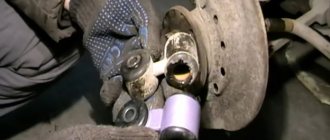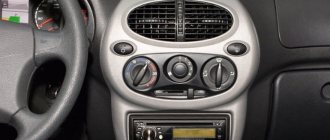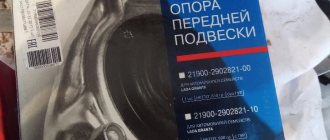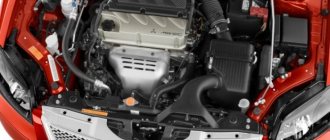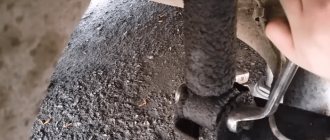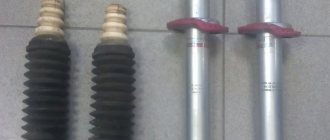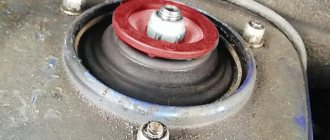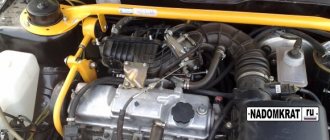Hi all! Surely you have heard about such a thing as body rigidity. This is a truly important feature for any vehicle. Especially for those cars that operate on less than ideal roads.
Therefore, today we will talk to you about why the front strut strut is needed and what the installation of these elements gives. This will allow you to understand whether it makes any sense to buy and install such an element. Or this is true for some special sports car.
I will try to answer all the most pressing questions, understand why the spacer is used, and how you can install it on your own car with your own hands.
If you're ready, then let's go!
Compatibility of stretch marks with other elements
Perhaps in the future you will decide to install a gas or hydraulic hood stop. This unit is attached to the right suspension strut using a bracket. In principle, you can install the hood extension and stop so that these parts do not interfere with each other. The main thing is to make sure that the bracket that holds the stop fits on the brace bracket.
A good example: a brace and a gas stop are attached to the racks
Now let's talk about such an option as crankcase protection. This protection is standardly present in the crossover and in the charged Kalina NFR, which is not yet produced. The front strut brace, if you install it together with the crankcase protection, must be equipped with an engine bar. The motor is attached to the rod with 4 bolts, and in the event of a collision it will be directed downwards.
The results of crash tests of the “berry crossover” indicate the following: after a frontal impact, the engine will not be in the cabin. The crankcase protection for this car was developed taking into account special requirements, and as a result, in the event of a strong frontal collision, the engine goes down and not back. The same cannot always be said about tuning kits offered by third-party companies. Make a choice.
Feedback after installing the strut stretcher
Analyzing the reviews of car enthusiasts, we can conclude that the majority (about 85%) consider the front strut brace to be a useful accessory and recommend its installation, even during normal, everyday driving.
One of the video reviews that most viewers agreed with:
How do you feel about this type of car tuning? Is it worth installing a front-end amplifier or is it all at the level of self-hypnosis? Participate in the survey and leave your feedback on this improvement.
Where can I buy
: In our online store (for Vesta, for XRAY, for Granta/Kalina, for Priora, for Largus, for Lada 4×4)
Let us remind you that a more controversial issue arises after installing the reinforcement for the rear part of the body (trunk). By the way, have you heard about the bumper booster?
Keywords: body amplifiers Lada Granta | body amplifiers for Lada Priora | body reinforcements for Lada Kalina | body amplifiers for Lada Largus | Lada Vesta body reinforcements | body amplifiers lada xray | body reinforcements 4x4 | Niva body reinforcements | universal article
0 0 0 0 0 0
Share on social networks:
Step-by-step installation instructions
The kit for installing guy wires includes: the main part, a set of washers and fasteners. Actually, in order to secure the brace on the Kalina-2 struts, you first need to unscrew the nuts securing the strut to the body. A 13 key is suitable here, and it is better if it is an open-end one.
- Opening the hood, you will see nuts that are screwed onto studs. These studs are mounted into the suspension strut supports. Depending on the type of fastening of the brace, two or three nuts are unscrewed on each side;
- The extension brackets are placed on the studs, first on the right (where the hoses go), then on the left side;
- Lastly, tighten the nuts on all studs.
After completing these steps, all that remains is to close the hood and conduct a short test drive. The fastening should not loosen after several kilometers, which the owner must verify for himself.
Varieties
Whether or not to install a spacer with additional support for the internal combustion engine is up to everyone to decide for themselves. Someone reads reviews and understands that such a modification would not be superfluous. For others, the car has a very high-quality body, strengthened at the production stage, and therefore no special additions are required.
As practice shows, most often among domestic motorists, spacers are installed:
- on Priora;
- VAZ 2114;
- VAZ 2110;
- Lada Granta;
- VAZ 2109;
- Subaru Impreza;
- Mazda 6GG;
- Lada Vesta;
- Nissan Almera Classic;
- domestic classics;
- VAZ 21099, etc.
Suppose you decide to install such an element for yourself. But before you make modifications to the car, you should understand what kind of struts there are and how they differ from each other.
This is quite an important point, since it is better to choose devices that are optimally suited to your vehicle.
Based on the number of fixation sites, there are 2 categories:
- Two-point. As you understand, these are spacers that have a pair of points for fixation to the body. They are mounted directly on the mudguard cups, that is, on the left and right sides. A fairly common and frequently used option. But not the most perfect and optimal for some cars;
- Three-point. Improved version. Here, a pair of the already mentioned fastenings are used, like the two-point one, but in addition there is another fixation point on the body. This creates a strengthened connection, and therefore this stretching works more effectively.
The main advantage of a three-point vehicle is maximum body rigidity. But here you will need to spend more time and effort on the installation process itself.
Devices are also differentiated depending on the adjustment. To be more precise, make adjustments whenever possible.
As a result, there are 2 types of structures:
- Unregulated. This is a one-piece part with no detachable components. Therefore, it will not be possible to somehow configure and regulate them. Non-adjustable options have lower rigidity parameters. They should be used only when there is no other design for your car;
- Adjustable. There is one important feature here. The design includes a pair of nodes, the connection between which is carried out using a special coupling. It is the coupling that makes it possible to change the length of the spacer to increase or decrease, depending on the situation.
It is also worth highlighting the differences across the cross-section. Spacers are divided into round and rectangular. Both options are identical in terms of rigidity and quality. Here the main role is played only by the thickness of the material. It is better to choose products with a thickness of 2-3 mm. There is no fundamental difference in the type of section. Choose what suits the configuration of your car.
Lada Granta front strut strut
Tuning begins when you want something more, but there is no money for another car. Well, or desires. I have both at once. We are talking about the grant of the “norm” configuration, the standards have a weaker engine, and the luxury ones have a different suspension, so the described sensations from the car may differ. But I think the information will be interesting to everyone
So, what is the first thing Granta lacks? Everything is fine with the dynamics, the 127 engine can slowly vomit and turn up the heat if necessary. There are also plenty of stock brakes, not counting the extreme modes. But this very limiting regime comes too early due to the lack of stability. If you ride calmly and leisurely no higher than 90 km/h, then everything is fine, the suspension is soft and absorbs bumps well. If the gearbox hadn't howled, it was probably the most comfortable car I've ever driven in. But upon reaching 100 km/h, this softness begins to play against us. The car begins to sway, roll in turns and float along the road. Usually in such cases the springs/shock absorbers are changed to stiffer ones, and this is partly correct. But I decided to dig deeper and read what athletes do, because as you know, most inventions related to cars come from motorsport
So here it is. First of all, in a production car, the body is strengthened, since it simply cannot withstand the increased loads and begins to deform to the point of destruction. Moreover, the bodies of production cars (especially budget ones) are quite soft against torsion and other types of deformation. While driving on an uneven road, when cornering and when changing speed, individual body elements begin to bend, introducing errors into the operation of the suspension. This is where the swaying, excessive rolls, etc. come from. The car is still new, I didn’t want to cook or drill at all, so I started looking for ready-made solutions, after all, VAZs are very common in our (and not only) country, and athletes also ride on them. The two companies that have the widest range in this regard are “Avtoprodukt” and “Tehnomaster”, and they have many products similar to each other. I studied the products of both companies for a long time, in the end I settled on “Autoproduct” due to a much lower price and practically the same functionality, although I’m still thinking about some items (more on this a little later)
Front top and bottom
The upper and lower parts are reinforced at the front. The most popular amplifier is the upper extension of the cups of the front shock absorber elements on the Lada Priora. Firstly, they are easy to install, and secondly, they are clearly visible under the hood; their presence, in the opinion of many, gives the car a sporty look. Such designs are indeed widely used in professional motorsport. But a brace alone doesn't make a car a race car.
The part is attached to the front suspension strut cups from above, which creates a rigid connection between the right and left parts of the body. The cost of these parts is 700-1600 rubles. The original Lada Sport spare part is designated by number 21100-8403770-87. Price about 900 rub.
In the manufacturers' catalog there are amplifiers designated as two- or three-point amplifiers, but they are called four- or six-point amplifiers. They differ in the number of mounting holes:
- For two-point ones - 2 on each side, 4 in total.
- Three-pointers have 3 each, for a total of 6.
Expensive models are available with six mounting holes on each side:
- Adjustable - the length can be changed, providing ease of installation on an old car with broken body geometry.
- Non-adjustable - simpler in design, more rigid, but suitable only for machines with the correct distance between glasses.
- A special type of strut is a stretching of the front struts for a Priora car, with an additional support attached to the engine (for a Priora with a 16 valve engine). The part allows you to increase the rigidity of the body and the mounting of the power unit. It has a complicated design and a price of 1600–2200 rubles.
The lower brace strengthens the suspension arms. The price of the lower part is 500–1200 rubles. The number of the lower reinforcing element of Lada Sport is 21100-5301265-87. Costs approximately 750 rubles. Many car enthusiasts note that installing a lower brace creates a more noticeable effect than adding reinforcement to the cups.
Which front strut brace is better to choose?
It is recommended to choose body reinforcements that meet the technical specifications and have passed the test cycle. Try to buy such accessories from trusted manufacturers (for example, TechnoMaster or AvtoProdukt).
Types of front strut struts:
- without adjustment (check before purchasing that the spacer fits the mounting points);
- with adjustment (easier installation, since it is possible to adjust the mounting points);
- with a hood stop (when it is possible to additionally install a gas hood stop);
- with an additional engine mount (an additional engine mount to reduce shocks/vibrations/jerking when starting to move/braking or when you sharply press/release the gas pedal, as when installing the rear gearbox mount on a Priora).
Installation of the spacer is shown in the video:
Features and purpose
The pipe support is used to reliably hold and secure the line, while preventing the material from deforming when exposed to temperature, and these fasteners also dampen vibration. The supports of steel process pipelines or heat supply largely determine its reliability during operation.
Therefore, increased requirements are put forward for selection and installation and generally accepted rules prescribed in a number of documentation are taken into account; there is a special table for the permissible distance between fixed or other fastenings (for example, SNiP for metal supports for pipelines).
Metal fasteners are used in various industries:
- Department of Housing and Utilities;
- nuclear and thermal power plants;
- industrial enterprises;
- oil and gas pipelines;
- in everyday life - when you need to lay a heating pipeline in your country house.
Fastenings can take on the following loads:
- torque;
- vibrations;
- expansion forces caused by pressure in the line;
- thermal expansion of elements;
- transverse, axial and vertical loads.
Choice of stretch
Having opened the hood of the Lada Kalina of the first family, above the right shock absorber strut we could find a bracket to which a rough road sensor (RSD) is attached. This was true for all trim levels except “Standard”. The braces connecting the suspension struts and intended for the “first Kalina” could be equipped with a bracket to which the DND had to be attached.
DND under the hood of Kalina-1, right pillarTypically, the compatibility list on the seller’s website contains the following models: VAZ-1117-1119, 2190, 2192-2194 (“Kalina-2”). The weight of the part itself rarely exceeds 4 kg, and its installation can be done by anyone who can handle a wrench.
The part called the stretcher is in its rightful place
The strut extension for the Kalina-2 car can be equipped with an additional rod that needs to be secured to the engine. An experienced technician can perform this operation without making mistakes. The most difficult part will be to adjust the engine rod, and this process is not covered here. We only note the following: it is always indicated which engine (16 or 8 valve) the rod is compatible with.
During the tuning, we will have to unscrew and re-tighten the nuts that secure the suspension strut supports. We are talking about nuts screwed onto studs. When performing installation, it is better to use suitable washers, otherwise the metal will be pressed through over time. VAZ does not standardly install such a stretch, which is true even for a crossover of the berry family. However, performing the tuning in question does not void the warranty.
Viburnum lower control arm spacer
Lower spacers for VAZ Avtoprodukt
Confident cornering at speed. — Increased body life. — Reduces the movement of the front suspension arm bracket by more than 3 times. — Reduces stress on the lever bracket and the spar-to-floor connector by 30%. - Reduces by 8%...
— Increasing the rigidity of the front suspension cross member. — Reduced load on cantilever bolts. — Increasing permissible loads and reducing the likelihood of deformation of bolts and cross members when driving off-road. Weight 0.7 kg Dimensions 535x53x28 mm The kit includes: - ..
— Confident cornering at speed. — Increased body life. — Up to 40% reduction in stress on the arm mounting brackets. — Reduces stress on the bulkhead and the right steering gear bracket by up to 12%. Weight 1.6 kg Dimensions 780..
— Increased rigidity of the front end of the body and suspension mounting points. — Up to 40% reduction in stress on the arm mounting brackets. — Up to 12% reduction in stress on the bulkhead and the right steering gear bracket. Weight 1.1 kg Dimensions 780x71x40 mm..
— Confident cornering at speed. — Increased body life. — Reduces the movement of the front suspension arm bracket by more than 3 times. — Reduces stress in the arm bracket and the spar-to-floor connector by 35%. — Reduces by 8.5%&n..
Front strut strut AvtoProdukt for Lada Granta, Kalina, Kalina 2
with 9% discount
Threshold seal RGI 135 for Lada Granta, Kalina, Kalina 2, datsun
with 10% discount
Vertical seal RKI 19 for Lada Granta, Kalina, Kalina 2, Largus
with 13% discount
Windshield wiper blade frameless brush 60cm.
with 18% discount
Tube for modifying the seals of the sliding windows of Lada Granta, Kalina, Kalina 2
with 19% discount
Increases the rigidity of the front end of the body and the suspension mounting points. Reduces stress on the arm mounting brackets by up to 30%, and the front panel by up to 8%. Additional attachment points allow you to install separate protection.
Increases the rigidity of the front end of the body and reduces stress at the mounting points of the front suspension supports.
Purpose: reduces the movement of the upper mounting points of the rear suspension struts, increases the overall rigidity of the body, reduces stress in the body elements. Applicability: Lada Kalina, Kalina 2, Granta, Datsun.
The rear arm extension AR 0226 / AR10-2914275 is installed on Lada Granta, Kalina, Kalina 2 (VAZ 2190, 1117, 1118, 1119) cars and their modifications.
Rear arm extension, PU AR 0227 / AR10-2914275-05 is installed on Lada Granta, Kalina, Kalina 2 (VAZ 2190, 1117, 1118, 1119) cars and their modifications.
Front strut with extension of the power unit 16-cl. AR 0421 / AR18-8403770-20 is installed on Lada Granta, Kalina, Kalina 2 (VAZ 2190, 1117, 1118, 1119) cars and their modifications.
VAZ Kalina Sport in-flight magazine (2015)
I have long been paying attention with interest to how car tuning is gradually changing in our country. In the early 80s, tuning was limited to a homemade braid on the steering wheel and a glass gearbox knob with a rosette inside. Curtains on the windows. PTFs. By the end of the 80s, the Classic VAZ began to be transformed in a different style: lower spoilers under the bumper (sometimes the standard bumpers were removed altogether), door sills, a wing on the trunk lid, “gills” on the rear window. All this combined with a steeply raised ass. With the 90s and the massive advent of Eights and Nines, this splendor gradually began to be supplemented with low-offset alloy wheels, creepy cast-iron tinting in a black-violet hue (usually applied with one’s own hand somehow), small steering wheels and “cool” imported radios shimmering with a cascade of multi-colored lights . Towards the end of the 90s, “perdans” began to come into fashion, and tuning itself moved from the outright “village” somewhat towards the professional side. The tint is now normal. The number of incredible plastic bells and whistles on the body has greatly decreased. In the 2000s, a certain turning point occurred. Putting your ass up in the air used to be cool, but now it has suddenly become a sign of a collective farm. The cool guys rushed in unison to lower their 9s, 12s, etc. In the 10s, the same turn happened regarding wheels. Wide, show-off alloy wheels suddenly became unpopular among the “tough guys” who needed to be at least somewhat different from the masses (such as the friend-or-foe system). Narrow stamped disks (of the “neat” type) have come into fashion, which are often even painted with good paint and polishing. This is the last squeak. Also, any use of overhead elements has become a sign of a “collective farm”. Now they act more subtly. A completely stock Four or Priora, but “My life My rules” is written on the body in beautiful small letters, and a bright yellow brake cylinder peeks out from under the wheel spokes. And now you are already a super-mega-cool pepper on a racing car that even Cayennes are embarrassed to compete with. Everyone applies modern tuning to the best of their “fine taste”. These could be painted brake mechanisms (clearly hinting at the incredible capabilities of the engine), small buckets on tow hooks (well, not gas masks), sharp profile rubber, inscriptions on the body, etc. That's it for now. We'll see what happens next.
Distances between pipeline supports according to the SNIP table
A correctly selected distance between the support fasteners is one of the operating conditions for the system. The supports allow you to distribute the load, minimize stress, and in certain cases - when arranging heating mains, for example, distribute the temperature load.
SNiP standards include requirements for the distance between supports for pipelines with different diameters, wall thicknesses and purposes. Such data is entered into special tables, which greatly facilitates calculations. It is worth remembering that the table does not contain recommended data, but an exact indication, corresponding to SNiP, how many and what structures are needed.
The table of distances between pipeline supports given in the article concerns sliding structures for steel pipes.
| Outer diameter, mm | Wall thickness, mm | Maximum distance between supports, m | Accepted distance for above-ground and underground installation, m | Accepted distance for underground installation in impassable channels, m |
| 25 | 2,5 | 2.5 | 1,9 | 1,9 |
| 32 | 2,5 | 3,2 | 2,7 | 2,7 |
| 40 | 2,5 | 3,9 | 3,0 | 3,0 |
| 57 | 2,5 | 4,9 | 3,8 | 3,8 |
| 76 | 3,0 | 6,4 | 4,9 | 3,8 |
| 89 | 3,0 | 6,9 | 5,3 | 4,1 |
| 108 | 3,5 | 8,3 | 6,4 | 4,9 |
| 133 | 4,0 | 9,6 | 7,4 | 5,6 |
| 159 | 4,0 | 10,4 | 8,0 | 6,1 |
| 219 | 4,0 | 12,8 | 9,8 | 6,4 |
| 273 | 4,5 | 14,7 | 11,3 | 7,9 |
| 325 | 5,0 | 16,6 | 12,8 | 8,3 |
| 377 | 5,5 | 18,3 | 14,1 | 9,2 |
| 426 | 6,0 | 19,8 | 15,2 | 9,9 |
| 530 | 7,0 | 22,7 | 17,5 | 11,4 |
| 630 | 8,0 | 25,6 | 19,7 | 12,8 |
| 720 | 8,5 | 27,7 | 21,3 | 13,9 |
| 820 | 9,5 | 30,3 | 23,3 | 15,2 |
| 920 | 10,0 | 31,9 | 24,5 | 16,0 |
| 1020 | 11,0 | 33,6 | 25,8 | 16,8 |
The distances between the supports of steel pipelines with equal wall sizes are determined by the diameter. The characteristics of the soil during underground installation also influence. In addition, when installing thermal routes in accordance with SNiP, the distance is affected by temperature deformation. For heating mains, only movable supports are used in order to create an installation offset to compensate for thermal expansion.
